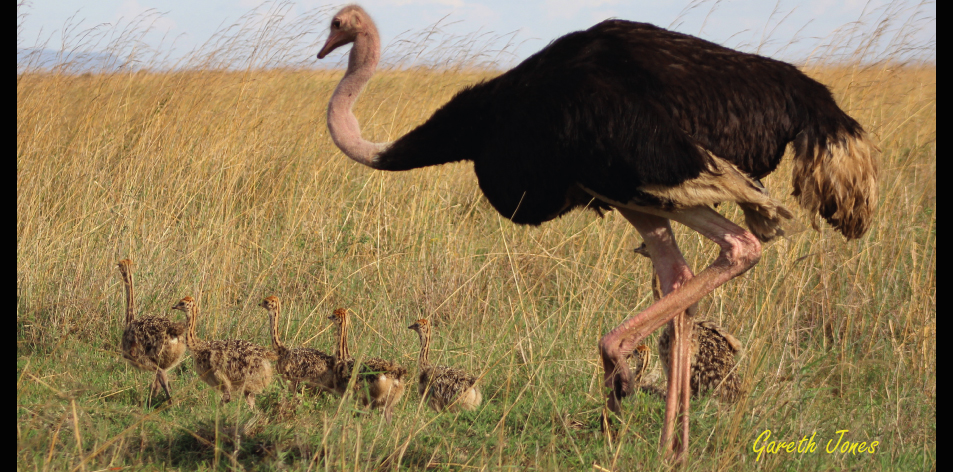
Flightless & Fast!!- Article by Gareth Jones
Flightless & Fast In The Nairobi National Park
One fine afternoon, I drove into the park from the East gate. An ostrich was walking quickly parallel to the road. So I drove slowly forward towards him, the ostrich responded by increasing its pace to a steady jog, and then began to run as I drove along at about 30km/h, this continued for over a kilometre as he seemingly, tirelessly ran slightly ahead of the vehicle over the grass next to the road. Then he suddenly broke into a sprint and darted across the road, with a zig-zag movement as though he was trying to get away from a predator. Then he stopped suddenly, and behaved as if I was not even there, and continued to look for suitable stones to digest on the ground. Maybe he just likes running to keep fit or just for the sheer joy of it?
They are interesting to watch, firstly they are the largest birds in the World, and they cannot fly due to size & weight. Males look majestic with black feathers and a white undercarriage, while the females are a drab grey. Imagine if women in our world all looked drab, and did not care for fashion? They also swallow stones to help with the digestion process, it’s no wonder they can’t fly with that extra weight! The species in the Nairobi Park are the common Masai sub-species with pink/reddish legs. Especially in the breeding season, the Nairobi National Park has a healthy thriving ostrich population. Kenya is also one of the few places where the rarer northern (Somali ostrich) sub-species with its blue legs is also found. Struthio is a genus of bird in the order Struthioniformes, whose members are the ostriches. There are two living species, the common ostrich and the Somali ostrich.
Ostriches have the biggest eyes of any land mammal – almost 5cm across – and three sets of eyelids. The size of their eyes helps them to easily see predators like lions from a long distance. Ostriches have three stomachs. Since they lack teeth, they swallow small stones to grind their food, and an adult ostrich carries nearly one kilogram of pebbles in its stomach. Ostriches can go without drinking for several days, absorbing moisture from the food they eat, but they do enjoy the water and will even bathe in it if there is enough. As ostriches can’t fly, when threatened they’ll run, and can reach speeds up to about 70km/h (43mph), covering up to 5m in a single stride. Their powerful, long legs can be formidable weapons, capable of killing a human or a potential predator with a forward kick. The front of their feet has a long claw-like toe that is an effective weapon when attacking or defending. Ostriches’ wings reach a span of about two metres and are used in mating displays, to shade chicks, to cover the bare skin of the upper legs to conserve heat, and as ‘rudders’ to help them change direction while running. But even with such large wings, due to their heavy bodies, they remain flightless.
Territorial fights between males for a harem of two to seven females usually last just minutes. What follows, is a complex mating ritual consisting of wing beats, poking on the ground, and then the male will violently flap his wings to symbolically clear out a nest in the dirt. The hen runs circles around the cock with lowered wings, and he will swirl his head. She drops to the ground and mating can commence.
All of the hens put their eggs in one basket (the dominant hen’s 3m-wide nest). The giant eggs are the largest of any living bird at 15cm long and weighing as much as two dozen chicken eggs. The eggs are incubated by the dominant female by day (her drab colours blend in with the sand) and by the male at night (his black feathers make him nearly undetectable in the dark). The communal nest may end up containing as many as 60 eggs! Eggs hatch after 35–45 days incubation, and the male usually defends the chicks and teaches them to feed, although mums and dads cooperate in rearing the young. Fewer than 10% of nests survive the 9-week period of laying and incubation, and of the surviving chicks, only 15% of those survive to 1 year of age. However, among those common ostriches who survive to adulthood, the species is one of the longest-living bird species. Common ostriches in captivity have lived to 62 years and 7 months.
Ostriches don’t bury their heads in the sand! This myth probably began from the bird’s defensive way of lying low at the approach of trouble and pressing themselves to the ground to try to be less visible. Their feathers blend well with sandy soil and, from a distance, they may look like they’ve buried their heads in the sand. The ostrich is farmed commercially around the world for its decorative feathers, its meat and its skin, which is used for leather products. The wild ostrich population has declined drastically in the last 200 years, with most surviving birds in protected game parks or reserves, or on farms.
Ostriches are the fastest and heaviest flightless bird species in the world. Spend a day in the park, go “birdwatching”, you will be surprised at how many other animals can also be seen if you slow down to the pace of nature.
The park is open daily from 06h00 to 19h00.


